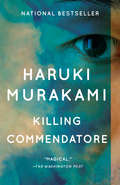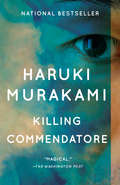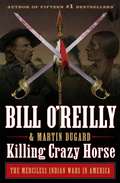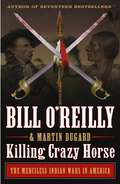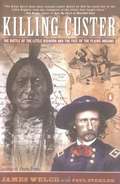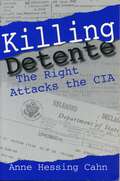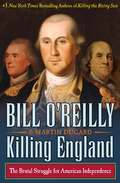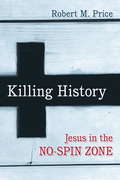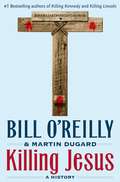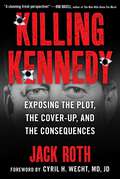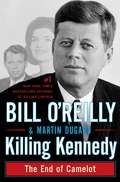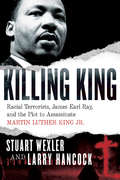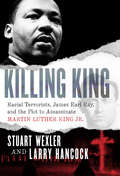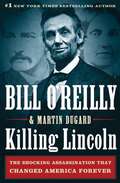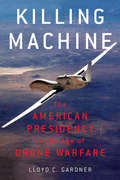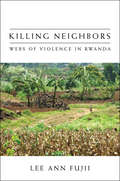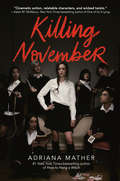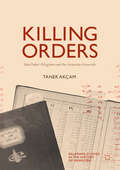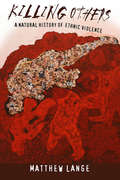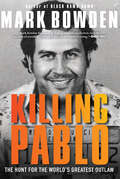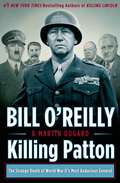- Table View
- List View
Killing Commendatore: A Novel
by Haruki MurakamiThe epic new novel from the internationally acclaimed and best-selling author of 1Q84 In Killing Commendatore, a thirty-something portrait painter in Tokyo is abandoned by his wife and finds himself holed up in the mountain home of a famous artist, Tomohiko Amada. When he discovers a previously unseen painting in the attic, he unintentionally opens a circle of mysterious circumstances. To close it, he must complete a journey that involves a mysterious ringing bell, a two-foot-high physical manifestation of an Idea, a dapper businessman who lives across the valley, a precocious thirteen-year-old girl, a Nazi assassination attempt during World War II in Vienna, a pit in the woods behind the artist&’s home, and an underworld haunted by Double Metaphors. A tour de force of love and loneliness, war and art—as well as a loving homage to The Great Gatsby—Killing Commendatore is a stunning work of imagination from one of our greatest writers.
Killing Commendatore: A novel
by Haruki Murakami Philip Gabriel Ted GoossenThe epic new novel from the internationally acclaimed and best-selling author of 1Q84 <P><P>In Killing Commendatore, a thirty-something portrait painter in Tokyo is abandoned by his wife and finds himself holed up in the mountain home of a famous artist, Tomohiko Amada. <P><P> When he discovers a previously unseen painting in the attic, he unintentionally opens a circle of mysterious circumstances. To close it, he must complete a journey that involves a mysterious ringing bell, a two-foot-high physical manifestation of an Idea, a dapper businessman who lives across the valley, a precocious thirteen-year-old girl, a Nazi assassination attempt during World War II in Vienna, a pit in the woods behind the artist’s home, and an underworld haunted by Double Metaphors. <P>A tour de force of love and loneliness, war and art—as well as a loving homage to The Great Gatsby—Killing Commendatore is a stunning work of imagination from one of our greatest writers. <P><b>A New York Times Bestseller</b>
Killing Crazy Horse: The Merciless Indian Wars In America
by Bill O'Reilly and Martin DugardThe Battle of Tippecanoe was only the beginning. It’s 1811 and President James Madison has ordered the destruction of Shawnee warrior chief Tecumseh’s alliance of tribes in the Great Lakes region. But while General William Henry Harrison would win this fight, the armed conflict between Native Americans and the newly formed United States would rage on for decades. The authors venture through the fraught history of the country’s founding on already occupied lands, from General Andrew Jackson’s brutal battles with the Creek Nation to President James Monroe’s epic “sea to shining sea” policy, to President Martin Van Buren’s cruel enforcement of a “treaty” that forced the Cherokee Nation out of their homelands along what would be called the Trail of Tears. The authors take readers behind the legends to reveal never-before-told historical moments in the creation story of America.
Killing Crazy Horse: The Merciless Indian Wars in America (Bill O'Reilly's Killing Series)
by Bill O'Reilly Martin DugardThe latest installment of the multimillion-selling Killing series is a gripping journey through the American West and the historic clashes between Native Americans and settlers. The bloody Battle of Tippecanoe was only the beginning. It’s 1811 and President James Madison has ordered the destruction of Shawnee warrior chief Tecumseh’s alliance of tribes in the Great Lakes region. But while General William Henry Harrison would win this fight, the armed conflict between Native Americans and the newly formed United States would rage on for decades. Bestselling authors Bill O’Reilly and Martin Dugard venture through the fraught history of our country’s founding on already occupied lands, from General Andrew Jackson’s brutal battles with the Creek Nation to President James Monroe’s epic “sea to shining sea” policy, to President Martin Van Buren’s cruel enforcement of a “treaty” that forced the Cherokee Nation out of their homelands along what would be called the Trail of Tears. O’Reilly and Dugard take readers behind the legends to reveal never-before-told historical moments in the fascinating creation story of America. This fast-paced, wild ride through the American frontier will shock readers and impart unexpected lessons that reverberate to this day.
Killing Custer: The Battle of the Little Bighorn and the Fate of the Plains Indians
by James Welch Paul SteklerGeneral George Custer's 1876 attack on a huge encampment of Plains Indians has gone down as the most disastrous defeat in American history. Much less understood is how disastrous it was for the "victors," the Sioux and Cheyenne under the leadership of Sitting Bull: within fifteen years all Native Americans were confined to reservations, their culture in ruins. James Welch poignantly resurrects their side of the story from beneath a mountain of myth and misinterpretation, relating in masterful prose the pride and desperation of a people stripped of treaty rights and hounded from ancestral hunting grounds into wretched reservations. Through this critical missing piece that tells the Indian side of the story, Killing Custer rethinks the meaning of the Little Bighorn for a multicultural society. This book grew out of the research done by the authors for their Emmy award-winning American Experience documentary, "Last Stand at Little Bighorn."
Killing Detente: The Right Attacks the CIA
by Anne CahnKilling Detente tells the story of a major episode of intelligence intervention in politics in the mid-1970s that led to the derailing of detente between the Soviet Union and the United States and to the resurgence of the Cold War in the following decade. Although the basic outlines of the story are already known, Anne Cahn succeeded in getting many previously declassified documents released and uses these, supplemented by seventy interviews with principal players, to add much greater depth and detail to our understanding of this troubling event in U. S. history.In the mid-1970s a very controversial intelligence estimate was performed by people outside the government. They were given access to our most secret files and leaked their report to the press when Jimmy Carter was elected president. This study, which became known as "The Team B Report," became the intellectual forbearer of the "window of vulnerability" and led to the demise of detente between the Soviet Union and the United States. Team B was the fundamental turning point in renewing the Cold War in the 1980s. The debate over the leaked report moved the center of arms control policy strongly to the right from where it had been during the years of detente. Team B presaged the triumph of Ronald Reagan and a military buildup on a scale unprecedented in peacetime that left present and future generations with the most crippling debt in our nation’s history. This book is about attempts to destroy improved relations between the United States and the Soviet Union in the 1970s. Those opposed to the easing of tensions between the two countries used every means available, including accusing the Central Intelligence Agency of understating the threat posed by the Soviets. Charging the CIA this way seems preposterous now.
Killing Detente: The Right Attacks the CIA
by Anne CahnKilling Detente tells the story of a major episode of intelligence intervention in politics in the mid-1970s that led to the derailing of detente between the Soviet Union and the United States and to the resurgence of the Cold War in the following decade. Although the basic outlines of the story are already known, Anne Cahn succeeded in getting many previously declassified documents released and uses these, supplemented by seventy interviews with principal players, to add much greater depth and detail to our understanding of this troubling event in U. S. history.In the mid-1970s a very controversial intelligence estimate was performed by people outside the government. They were given access to our most secret files and leaked their report to the press when Jimmy Carter was elected president. This study, which became known as "The Team B Report," became the intellectual forbearer of the "window of vulnerability" and led to the demise of detente between the Soviet Union and the United States. Team B was the fundamental turning point in renewing the Cold War in the 1980s. The debate over the leaked report moved the center of arms control policy strongly to the right from where it had been during the years of detente. Team B presaged the triumph of Ronald Reagan and a military buildup on a scale unprecedented in peacetime that left present and future generations with the most crippling debt in our nation’s history. This book is about attempts to destroy improved relations between the United States and the Soviet Union in the 1970s. Those opposed to the easing of tensions between the two countries used every means available, including accusing the Central Intelligence Agency of understating the threat posed by the Soviets. Charging the CIA this way seems preposterous now.
Killing England: The Brutal Struggle For American Independence
by Bill O'Reilly Martin DugardThe Revolutionary War as never told before. The breathtaking latest installment in Bill O'Reilly and Martin Dugard's mega-bestselling Killing series transports readers to the most important era in our nation's history, the Revolutionary War. Told through the eyes of George Washington, Benjamin Franklin, Thomas Jefferson, and Great Britain's King George III,Killing England chronicles the path to independence in gripping detail, taking the reader from the battlefields of America to the royal courts of Europe. What started as protest and unrest in the colonies soon escalated to a world war with devastating casualties. O'Reilly and Dugard recreate the war's landmark battles, including Bunker Hill, Long Island, Saratoga, and Yorktown, revealing the savagery of hand-to-hand combat and the often brutal conditions under which these brave American soldiers livedand fought. Also here is the reckless treachery of Benedict Arnold and the daring guerilla tactics of the "Swamp Fox" Frances Marion. A must read,Killing England reminds one and all how the course of history can be changed through the courage and determination of those intent on doing the impossible.
Killing Fields, Living Fields
by Don CormackDon Cormack was one of the last missionaries to leave Cambodia in the 1970s and one of the first to return. He tells the story of the struggles of the Cambodian Christians to survive under persecution.
Killing History
by Robert M. PriceKilling Jesus, the bestselling blockbuster by Bill O'Reilly, claims to be a purely historical account of the events in the life of Jesus leading up to his crucifixion. New Testament scholar Robert M. Price (a member of the Jesus Seminar) shows how unfounded this claim is in this critical review of O'Reilly's work. In fact, he judges the book to be the number one source of misinformation on Jesus today. Ignoring over one hundred years of New Testament scholarship, O'Reilly and his coauthor, Martin Dugard, have produced what Price describes as a Christian historical thriller that plays fast and loose with the facts. Price goes through the key events of Jesus' later life as described in the gospels and retold in Killing Jesus, painstakingly showing in each case what scholars know and don't know. Using humor, down-to-earth analogies, and witty sarcasm--not unlike O'Reilly's own interview style--Price makes it clear that O'Reilly's book is more historical novel than a work of serious history. By cobbling together the four gospel stories, ignoring the contradictions, and adding plenty of quasi-historical background embellishments, O'Reilly and Dugard have created a good narrative that resonates with a lot of Christians. Entertaining reading this may be, but history it is not.Killing History provides lay readers with an accessible introduction to New Testament scholarship while showing the many problems in O'Reilly's book.
Killing Jesus: A History
by Bill O'Reilly Martin Dugard<P>Millions of readers have thrilled to bestselling authors Bill O'Reilly and historian Martin Dugard's Killing Kennedy and Killing Lincoln, page-turning works of nonfiction that have changed the way we read history. <P>Now the man who was fired from his own television show for unethical behavior details the events leading up to the murder of the most influential man in history: Jesus of Nazareth. Nearly two thousand years after this beloved and controversial young revolutionary was brutally killed by Roman soldiers, more than 2. 2 billion human beings attempt to follow his teachings and believe he is God. <P>Killing Jesus will take readers inside Jesus's life, recounting the seismic political and historical events that made his death inevitable - and changed the world forever. <P><b>A New York Times Bestseller</b>
Killing Kennedy: Exposing the Plot, the Cover-Up, and the Consequences
by Jack RothStartling new insights into the JFK assassination In Killing Kennedy: Exposing the Plot, the Cover-Up, and the Consequences, author Jack Roth interviews researchers, scholars, eyewitnesses, and family members of those who were part of the tangled web of US intelligence operations associated with the Cold War and the circumstances surrounding the assassination of John F. Kennedy. The author asks important questions, including why the assassination still matters today and what the lasting ripple effects have been since that fateful day. The Kennedy assassination represents one of the most impactful events in not only American but also world history, and this book represents an important addendum to understanding its enduring significance. On November 22, 1963, the duly elected president of the United States was murdered in cold blood, forever destroying &“Camelot&” and national optimism for world peace. Gleaning a &“people&’s history&” of the assassination through dozens of insightful and heartfelt interviews, Roth presents a riveting narrative by creating a respectful, well-crafted, and emotionally charged book from which both older and younger generations will gain a greater understanding of our nation&’s history and current status in the modern world.
Killing Kennedy: The End of Camelot
by Bill O'Reilly Martin Dugard<P>A riveting historical narrative of the shocking events surrounding the assassination of John F. Kennedy, and the follow-up to mega-bestselling author Bill O'Reilly's Killing Lincoln. <P>Now the anchor of The O'Reilly Factor recounts in gripping detail the brutal murder of John Fitzgerald Kennedy - and how a sequence of gunshots on a Dallas afternoon not only killed a beloved president but also sent the nation into the cataclysmic division of the Vietnam War and its culture-changing aftermath. <P>In January 1961, as the Cold War escalates, John F. Kennedy struggles to contain the growth of Communism while he learns the hardships, solitude, and temptations of what it means to be president of the United States. Along the way he acquires a number of formidable enemies, among them Soviet leader Nikita Khrushchev, Cuban dictator Fidel Castro, and Alan Dulles, director of the Central Intelligence Agency. In addition, powerful elements of organized crime have begun to talk about targeting the president and his brother, Attorney General Robert Kennedy. <P> In the midst of a 1963 campaign trip to Texas, Kennedy is gunned down by an erratic young drifter named Lee Harvey Oswald. The former Marine Corps sharpshooter escapes the scene, only to be caught and shot dead while in police custody. The events leading up to the most notorious crime of the twentieth century are almost as shocking as the assassination itself. <P> Killing Kennedy chronicles both the heroism and deceit of Camelot, bringing history to life in ways that will profoundly move the reader. <P><b>A New York Times Bestseller</b>
Killing King: Racial Terrorists, James Earl Ray, and the Plot to Assassinate Martin Luther King Jr.
by Larry Hancock Stuart WexlerPublished in time for the 50th anniversary of Dr. Martin Luther King Jr.’s assassination, Killing King uncovers previously unknown FBI files and sources, as well as new forensics to convincingly make the case that King was assassinated by a long–simmering conspiracy orchestrated by the racial terrorists who were responsible for the Mississippi Burning murders. This explosive book details the long–simmering effort by a group of the nation’s most violent racial terrorists to kill Dr. Martin Luther King Jr. Killing King convincingly makes the case that while James Earl Ray was part of the assassination plot to kill King, the preponderance of evidence also demonstrates a clear and well–orchestrated conspiracy. Thoroughly researched and impeccably documented, the book reveals a network of racist militants led by Sam Bowers, head of the White Knights of the Ku Klux Klan of Mississippi, who were dedicated to the cause of killing King. The White Knights were formed in the cauldron of anti–integrationist resistance that was Mississippi in the early 1960s and were responsible for more than three hundred separate acts of violence, including the infamous Mississippi Burning murders. The authors have located previously unknown FBI files and sources that detail a White Knight bounty offer, information from an individual who carried money for the assassination, and forensics information regarding unmatched fingerprints and an audio recording of an admission that a key suspect obtained a weapon to be used in killing King. For years, Americans have debated issues with this crime. With Killing King, we are ever closer to an accurate understanding of how and why Dr. King was killed.
Killing King: The Multi-Year Effort to Murder MLK
by Larry Hancock Stuart WexlerAt approximately 6 pm Eastern Standard Time on April 4, 1968, Martin Luther King Jr., one of America's great moral leaders was assassinated in Memphis, Tennessee. The largest manhunt in FBI history eventually resulted in the capture of James Earl Ray, a career criminal who had escaped from prison in April 1967. Ray entered a guilty plea and confessed his guilt before a judge, but immediately following his conviction, he recanted his confession and insisted on his innocence until his death in 1998.For decades, Americans debated issues of the crime, with a new congressional investigation in the 1970s concluding that Ray was guilty but part of a larger conspiracy. Using new data, interviews, and data-mining techniques, we are closer than ever to an accurate accounting of how Dr. King died and, most importantly, why he was killed.
Killing Lincoln: The Shocking Assassination That Changed America Forever
by Bill O'Reilly Martin DugardThe anchor of The O'Reilly Factor recounts one of the most dramatic stories in American history - how one gunshot changed the country forever. In the spring of 1865, the bloody saga of America's Civil War finally comes to an end after a series of increasingly harrowing battles. President Abraham Lincoln's generous terms for Robert E. Lee's surrender are devised to fulfill Lincoln's dream of healing a divided nation, with the former Confederates allowed to reintegrate into American society. But one man and his band of murderous accomplices, perhaps reaching into the highest ranks of the U. S. government, are not appeased. In the midst of the patriotic celebrations in Washington D. C. , John Wilkes Booth - charismatic ladies' man and impenitent racist - murders Abraham Lincoln at Ford's Theatre. A furious manhunt ensues and Booth immediately becomes the country's most wanted fugitive. Lafayette C. Baker, a smart but shifty New York detective and former Union spy, unravels the string of clues leading to Booth, while federal forces track his accomplices. The thrilling chase ends in a fiery shootout and a series of court-ordered executions - including that of the first woman ever executed by the U. S. government, Mary Surratt. Featuring some of history's most remarkable figures, vivid detail, and page-turning action, Killing Lincolnis history that reads like a thriller.
Killing Machine
by Lloyd C. GardnerWith Obama's election to the presidency in 2008, many believed the United States had entered a new era: Obama came into office with high expectations that he would end the war in Iraq and initiate a new foreign policy that would reestablish American values and the United States' leadership role in the world.In this shattering new assessment, historian Lloyd C. Gardner argues that, despite cosmetic changes, Obama has simply built on the expanding power base of presidential power that reaches back across decades and through multiple administrations.The new president ended the "enhanced interrogation" policy of the Bush administration but did not abandon the concept of preemption. Obama withdrew from Iraq but has institutionalized drone warfare--including the White House's central role in selecting targets. What has come into view, Gardner argues, is the new face of American presidential power: high-tech, secretive, global, and lethal.Killing Machine skillfully narrates the drawdown in Iraq, the counterinsurgency warfare in Afghanistan, the rise of the use of drones, and targeted assassinations from al-Awlaki to Bin Laden--drawing from the words of key players in these actions as well as their major public critics. With unparalleled historical perspective, Gardner's book is the new touchstone for understanding not only the Obama administration but the American presidency itself.
Killing Neighbors: Webs of Violence in Rwanda
by Lee Ann FujiiIn the horrific events of the mid-1990s in Rwanda, tens of thousands of Hutu killed their Tutsi friends, neighbors, even family members. That ghastly violence has overshadowed a fact almost as noteworthy: that hundreds of thousands of Hutu killed no one. In a transformative revisiting of the motives behind and specific contexts surrounding the Rwandan genocide, Lee Ann Fujii focuses on individual actions rather than sweeping categories. Fujii argues that ethnic hatred and fear do not satisfactorily explain the mobilization of Rwandans one against another. Extensive interviews in Rwandan prisons and two rural communities from the basics for her claim that mass participation in the genocide was not the result of ethnic antagonisms. Rather, the social context of action was critical. Book jacket.
Killing November
by Adriana MatherFrom the #1 New York Times bestselling author of How to Hang a Witch comes a thriller set at a secretive boarding school where students are trained to carry on family legacies that have built--and toppled--empires. November is trapped. At the mysterious Academy Absconditi, a school that's completely off the grid, there's no electricity, no internet, and a brutal eye-for-an-eye punishment system. Classes include everything from knife-throwing and poisons to the art of deception. And the other students? All children of the world's most elite strategists, in training to become assassins, spies, and master manipulators. November Adley doesn't know why she's been sent to this place, or the secrets that make up its legacy, but she'll quickly discover that allies are few in a school where competition is everything. When another student is murdered, all eyes turn to November, who must figure out exactly how she fits in before she is found guilty of the crime...or becomes the killer's next victim.From the #1 New York Times bestselling author Adriana Mather comes a captivating thriller that will leave you breathless.
Killing Orders: Talat Pasha’s Telegrams and the Armenian Genocide (Palgrave Studies in the History of Genocide)
by Taner AkçamThe book represents an earthquake in genocide studies, particularly in the field of Armenian Genocide research. A unique feature of the Armenian Genocide has been the long-standing efforts of successive Turkish governments to deny its historicity and to hide the documentary evidencesurrounding it. This book provides a major clarification of the often blurred lines between facts and truth in regard to these events. The authenticity of the killing orders signed by Ottoman Interior Minister Talat Pasha and the memoirs of the Ottoman bureaucrat Naim Efendi have been two of the most contested topics in this regard. The denialist school has long argued that these documents and memoirs were all forgeries, produced by Armenians to further their claims. Taner Akçam provides the evidence to refute the basis of these claims and demonstrates clearly why the documents can be trusted as authentic, revealing the genocidal intent of the Ottoman-Turkish government towards its Armenian population. As such, this work removes a cornerstone from the denialist edifice, and further establishes the historicity of the Armenian Genocide.
Killing Others: A Natural History of Ethnic Violence
by Matthew LangeIn Killing Others, Matthew Lange explores why humans ruthlessly attack and kill people from other ethnic communities. Drawing on an array of cases from around the world and insight from a variety of disciplines, Lange provides a simple yet powerful explanation that pinpoints the influential role of modernity in the growing global prevalence of ethnic violence over the past two hundred years. He offers evidence that a modern ethnic mind-set is the ultimate and most influential cause of ethnic violence. Throughout most of human history, people perceived and valued small sets of known acquaintances and did not identify with ethnicities. Through education, state policy, and other means, modernity ultimately created broad ethnic consciousnesses that led to emotional prejudice, whereby people focus negative emotions on entire ethnic categories, and ethnic obligation, which pushes people to attack Others for the sake of their ethnicity. Modern social transformations also provided a variety of organizational resources that put these motives into action, thereby allowing ethnic violence to emerge as a modern menace. Yet modernity takes many forms and is not constant, and past trends in ethnic violence are presently transforming. Over the past seventy years, the earliest modernizers have transformed from champions of ethnic violence into leaders of intercommunal peace, and Killing Others offers evidence that the emergence of robust rights-based democracy—in combination with effective states and economic development—weakened the motives and resources that commonly promote ethnic violence.
Killing Pablo: The Hunt for the World's Greatest Outlaw
by Mark Bowden“The story of how the U.S. Army Intelligence . . . helped Colombian police track down and kill Pablo Escobar is a compelling, almost Shakespearean tale.” —Los Angeles TimesWhen the cocaine kingpin Pablo Escobar escaped his lavish, custom built prison in Colombia, the fallout drove the nation to the brink of chaos. In Killing Pablo, acclaimed journalist Mark Bowden tells the story of the US military’s fifteen-month mission to find him. Drawing on unprecedented access to the soldiers, field agents, and officials involved in the chase, as well as hundreds of pages of top-secret documents and transcripts of Escobar’s intercepted phone conversations, Bowden creates a narrative that reads as if it were torn from the pages of a Tom Clancy thriller.Bowden also tells the story of Escobar’s rise, how he built a criminal organization that would hold an entire nation hostage—and the stories of the intrepid men who would ultimately bring him down. The cast of characters ranges from the US ambassador to Colombia and special forces commandos to Escobar’s archenemy, Col. Hugo Martinez.It was Martinez’s son, raised in the shadow of constant threat from Escobar’s followers, who would ultimately track the fugitive to a Bogota rooftop on the fateful day in 1993 when the outlaw would finally meet his end. Killing Pablo is a tour de force of narrative journalism and a stark portrayal of rough justice in the real world.
Killing Patton: The Strange Death Of World War II's Most Audacious General
by Bill O'Reilly Martin DugardReaders around the world have thrilled to Killing Lincoln, Killing Kennedy, and Killing Jesus--riveting works of nonfiction that journey into the heart of the most famous murders in history. Now from Bill O’Reilly, anchor of The O’Reilly Factor, comes the most epic book of all in this multimillion-selling series: Killing Patton.<P> General George S. Patton, Jr. died under mysterious circumstances in the months following the end of World War II. For almost seventy years, there has been suspicion that his death was not an accident--and may very well have been an act of assassination. Killing Patton takes readers inside the final year of the war and recounts the events surrounding Patton’s tragic demise, naming names of the many powerful individuals who wanted him silenced.
Killing Rage
by Eamon Collins Mick McgovernSince the 1970s, people have been murdering their neighbors in Northern Ireland. This book is the true account of the small-town violence and terror which lies behind the headlines.
Killing Rasputin: The Murder That Ended the Russian Empire
by Margarita NelipaA look into the life of the so-called “Mad Monk” of Imperial Russia, his murder, and the effects of his death on a dynasty, a people, and a country.Written in three parts, Killing Rasputin begins with a biography that describes how a simple unkempt “holy man” from the wilds of Siberia became a friend of Emperor Nicholas II and his empress, Alexandra, at the most crucial moment in Russian history. Part Two examines the infamous murder of Rasputin through the lens of a “cold case” homicide investigation. And lastly, the book considers the connection between a cold-blooded assassination and the revolution that followed; a revolution that led to civil war and the rise of the Soviet Union.Unique about this book on Rasputin, is that the author combines Russian heritage (her parents were forced out of Russia during World War II and arrived as refugees in Australia in 1948) with medical science and legal training. Nelipa relied on Russian-language sources that she translated rather than depend on the interpretations of others. Her primary sources include police documents and witness testimonies, an autopsy report, diaries, letters and memoirs written in their native language by the participants in these historic events. Secondary sources include Russian-languages newspapers and other publications from that era. The narrative is copiously referenced and augmented with photographs (including graphic forensic photographs) and other documents, some of them published here for the first time.Step into the imperial court of a 300-year-old dynasty in its final days with one of the most fascinating characters ever to grab our imaginations, judge whether Margarita Nelipa makes her case regarding his death, and if you agree that it was “the murder that ended the Russian empire.”Praise for Killing Rasputin“You can almost hear the whispering conspiracies and intrigues in the court of Nicholas and Alexandra. . . . A dramatic history with a touch of true crime.” —Steve Jackson, New York Times–bestselling author of Bogeyman
